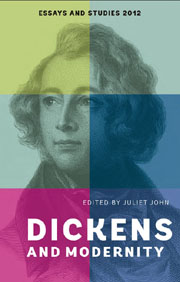Book contents
- Frontmatter
- Contents
- LIST OF ILLUSTRATIONS
- ACKNOWLEDGEMENTS
- NOTES ON THE CONTRIBUTORS
- INTRODUCTION
- 1 THE DICKENS TAPE: AFFECT AND SOUND REPRODUCTION IN THE CHIMES
- 2 DICKENS, SEXUALITY AND THE BODY; OR, CLOCK LOVING: MASTER HUMPHREY'S QUEER OBJECTS OF DESIRE
- 3 TEXTS, PARATEXTS AND ‘E-TEXTS’: THE POETICS OF COMMUNICATION IN DICKENS'S JOURNALISM
- 4 CORPUS STYLISTICS – DICKENS, TEXT-DRIVENNESS AND THE FICTIONAL WORLD
- 5 THINGS, WORDS AND THE MEANINGS OF ART
- 6 DICKENS AND THE CIRCUS OF MODERNITY
- 7 THE OLIVER! PHENOMENON; OR, ‘PLEASE, SIR, WE WANT MORE AND MORE!’
- 8 ‘WOW! SHE'S A LESBIAN. GOT TO BE!’: RE-READING/RE-VIEWING DICKENS AND NEO-VICTORIANISM ON THE BBC
- 9 OUT OF PLACE: DAVID COPPERFIELD'S IRRESOLVABLE GEOGRAPHIES
- 10 AFTERWORD: THE 2012 BICENTENARY
- Index
2 - DICKENS, SEXUALITY AND THE BODY; OR, CLOCK LOVING: MASTER HUMPHREY'S QUEER OBJECTS OF DESIRE
Published online by Cambridge University Press: 05 February 2013
- Frontmatter
- Contents
- LIST OF ILLUSTRATIONS
- ACKNOWLEDGEMENTS
- NOTES ON THE CONTRIBUTORS
- INTRODUCTION
- 1 THE DICKENS TAPE: AFFECT AND SOUND REPRODUCTION IN THE CHIMES
- 2 DICKENS, SEXUALITY AND THE BODY; OR, CLOCK LOVING: MASTER HUMPHREY'S QUEER OBJECTS OF DESIRE
- 3 TEXTS, PARATEXTS AND ‘E-TEXTS’: THE POETICS OF COMMUNICATION IN DICKENS'S JOURNALISM
- 4 CORPUS STYLISTICS – DICKENS, TEXT-DRIVENNESS AND THE FICTIONAL WORLD
- 5 THINGS, WORDS AND THE MEANINGS OF ART
- 6 DICKENS AND THE CIRCUS OF MODERNITY
- 7 THE OLIVER! PHENOMENON; OR, ‘PLEASE, SIR, WE WANT MORE AND MORE!’
- 8 ‘WOW! SHE'S A LESBIAN. GOT TO BE!’: RE-READING/RE-VIEWING DICKENS AND NEO-VICTORIANISM ON THE BBC
- 9 OUT OF PLACE: DAVID COPPERFIELD'S IRRESOLVABLE GEOGRAPHIES
- 10 AFTERWORD: THE 2012 BICENTENARY
- Index
Summary
By way of an abstract
This essay comes out of Dickens's fascination with stuff: specifically his interrelated interests in strange bodies and strange things. It brings together lines of enquiry inspired by thing theory, queer theory and gender studies to explore Dickens's investment in the imaginative, emotional and erotic appeal of objects. I suggest that in conjunction these approaches reveal the centrality of the material to Dickens's queer imagination, as his thinking on human/object relations participates in his wider scrutiny of the naturalness and inevitability of gender roles, heterosexuality, and, indeed, the human. In this I am particularly inspired by William Cohen's recent treatment of queer, which is not (just) about ‘sexual counterorthodoxy’ but about a presentation of ‘the openness of the body to the world by the senses as a type of permeability, or penetrability, that is not reducible to heterosexuality, nor is it even limited to the realm of the sexual’. Queer theory here meets posthuman and cyborgian approaches, offering a ‘critique of the human – with its phantasmatic completeness and integrity’ (2008: 134). I take as my focus the bizarre text Master Humphrey's Clock as Dickens's most explicit meditation on the joys of object-loving.
Reading Dickensian sex
Dickens's work is ‘absolutely saturated’, James Eli Adams recently announced, with sexuality (235). Eli Adams reads the sexual as cannily presented by Dickens as blatant public spectacle rather than a hidden truth uncovered through careful critical excavation.
- Type
- Chapter
- Information
- Dickens and Modernity , pp. 41 - 60Publisher: Boydell & BrewerPrint publication year: 2012

